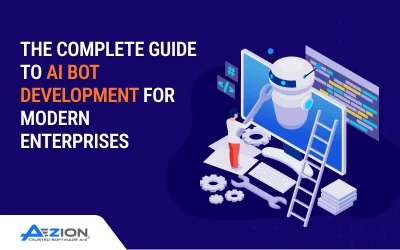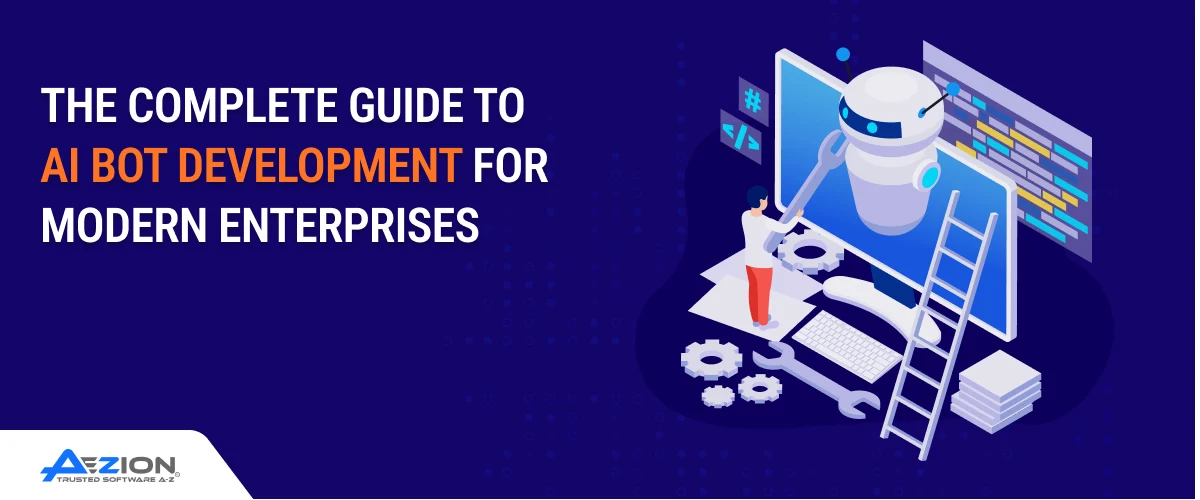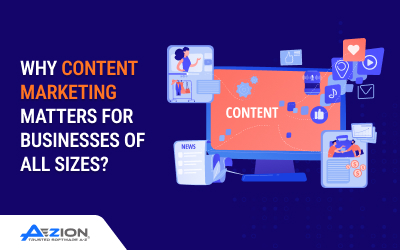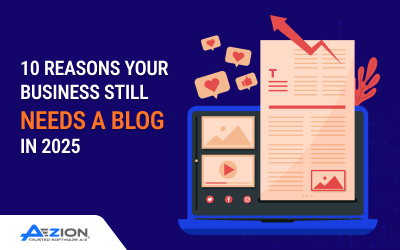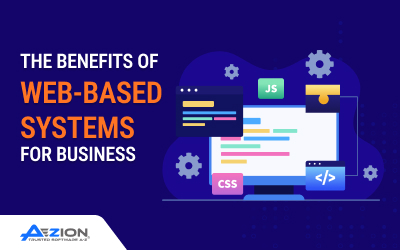Introduction to AI Bot Development
In the fast-moving digital world of 2025, AI Bots are no longer a simple support mechanism; they are now groundbreaking enablers of business. AI Bots now serve customers via customer service chatbots and knowledge aides, to become autonomous workflow agents. AI Bots represent the soul of enterprise automation and innovation.
For organizations oriented towards the future, developing AI Bots is not an experiment; it’s a requirement. Building AI Bots is easier to construct using underlying models, such as large language models (LLMs), incorporating natural language interfaces, RAG (retrieval-augmented generation) is just the next logical step from the still very early algorithms of AI chatbots; these AI Bots are now smart, contextual Bot and creating hyper-personalized experiences at scale.
However, deploying a successful AI bot is more than simply selecting a platform. It calls for a holistic lineup of business, scalable design, and good governance.
In this blog, we will see how to map a possible landscape of AI bot development, beginning with an agreement of the business goal, to the deployment of the bot to the relevant channel, and how to ensure a sustainable long-term effort.
Understanding AI Bots
1. What is AI Bot Development?
AI bot development involves defining your goals, selecting a platform or technology (such as LLMs or NLP services), creating conversation flows, integrating APIs or data sources, training the bot with relevant data, testing for accuracy, and deploying across desired channels.
Technologies for AI Bots are:
- Rule-Based Bots: Simple bots that execute preset decision trees. Fast to implement, but inflexible and choke on anything other than scripted flows.
- Machine Learning (ML)-Based Bots: These bots use supervised learning algorithms to learn over time based on user engagement patterns. More flexible, but still limited in overall understanding of user behavior.
- Generative AI Bots (LLM-Powered): With large language models such as OpenAI GPT, Google Gemini, or Anthropic Claude, these bots can read and comprehend complex programs, generate human-like responses, and adapt responses to multiple contexts. They are at the cutting edge of AI bot innovation today.
2. What are the types of bots?
As businesses extend their digital experience strategies, bots have become available in various forms. Here are some of the major types of bots:
- Chatbots: Most frequent, text-based robots utilized on websites, apps, and support systems.
- Voice Bots: Voice-based agents embedded in IVRs, mobile applications, or intelligent devices for conversational interaction.
- Multimodal Bots: Robots that integrate text, voice, and visual are critical in contemporary UX, especially in healthcare, education, and retail.
3. Bot Development Platforms
The bot development ecosystem has significantly expanded. The selection of the platform relies on the level of control, scalability, and business complexity desired:
- Prebuilt Platforms: Dialogflow, Botpress, and Microsoft Bot Framework are suitable for rapid deployments with minimal customizations.
- Custom LLM Integrations: Solutions such as OpenAI APIs, Azure OpenAI, Claude, and Gemini provide greater control when utilized together with RAG for domain knowledge.
- Hybrid Approaches: Combine platform UI workflows with generative backends to utilize the strengths of both worlds’ business logic and LLM flexibility.
Our innovation engineers at Aezion assess these solutions according to your business goals, data readiness, and growth aspirations. We are an innovative engineering firm, and we make sure the technology underneath is designed to enable long-term adaptability, which makes bots smarter and not outdated.
Key Advantages of AI Bot Development for Enterprises
For contemporary businesses, creating AI bots is no longer a tech update; it’s a strategic force behind operational optimization, user experience, and sustainable growth. As innovation becomes a business necessity, AI bots are useful instruments for assisting with automated conversations, process simplification, and discovering new streams of value.
The following are the significant benefits of spending on intelligent, enterprise-grade AI bots:
1. 24/7 Availability
AI bots operate around the clock without fatigue, ensuring your business is “always on.” Whether handling customer inquiries at midnight or assisting internal teams during off-hours, bots eliminate delays while reducing the need for large support teams. This translates into significant cost savings and enhanced customer experience.
2. Personalization
AI bots aren’t only for customers. Corporate copilots can assist employees in pulling out policies, creating documents, or troubleshooting IT problems in an instant. That minimizes context-switching, reduces reliance on human support desks, and frees up teams to do high-value work.
3. Improved Productivity and Employee Enablement
AI bots aren’t just for customers. Internal copilots can help employees retrieve policies, generate documents, or resolve IT issues instantly. This reduces context-switching, minimizes dependencies on human support desks, and empowers teams to focus on high-value work.
4. Scalability
Current-day AI bots can be easily scaled across departments, geography, and communication channels. This may be achieved without huge infrastructure investments. With strong architecture and the appropriate deployment strategy (cloud, on-prem, or hybrid), your bot infrastructure can scale as your business scales.
5. A Competitive Advantage
Companies that collaborate with an innovation engineering firm like Aezion are able to create bots not only for today’s needs but also for future-ready ones. Our innovation engineering professionals build scalability, compliance, and smarts into each stage of development, yielding long-term ROI and flexibility.
How to Plan Your AI Bot Development Roadmap
A successful AI bot development experience begins with careful planning well beyond tech choice. From setting specific objectives to having the proper data and organizational structure, your plan creates the foundation for a high-performing, future-ready bot.
This is where the capability of an innovation engineering firm comes into play. Specialists in this area can assist in introducing disciplined thinking, cross-functional cooperation, and scalable frameworks into your bot efforts.
1. Establish Business Goals and Bot Use Cases
Each AI bot must exist to deliver a precise function, be it lowering customer support expenses, simplifying onboarding, or enhancing internal processes. Establish quantifiable objectives with business KPI-based alignment. Common use cases are:
- Customer support and service automation
- Lead qualification and sales enablement
- HR or IT support assistants
- Knowledge management copilots
2. User Journeys Mapping and Integrations
User experience is paramount. Begin by creating a desired user journey for each target persona. Determine what the bot should do, say, & escalate to, and how it integrates with your current processes.
Then, plan for necessary integrations with:
- CRMs like Salesforce, HubSpot
- Ticketing systems like Zendesk, Freshdesk
- Knowledge bases, APIs, internal databases
- Enterprise identity systems like SSO and LDAP
This stage make sure your bot becomes an intelligent extension of your ecosystem, not a disconnected widget.
3. Review Data Readiness and Governance Requirements
AI bots live on high-quality, structured, and retrievable data, particularly LLM-based ones. Business owners should consider if their knowledge repository is well-organized and digitized, if there is structured metadata and taxonomy, and if sensitive information is access-controlled or redacted.
Innovation engineering professionals assist in evaluating data pipelines and suggesting improvements, frequently merging data engineering with AI bot logic to maintain security, velocity, and context awareness.
4. Define Team Roles and Budget
AI bot development is cross-disciplinary. Standard roles are:
- Product Owner – sets use cases and KPIs
- AI Engineer or Bot Developer – develops and integrates the bot
- Data Engineer – makes backend and data readiness
- Prompt/Conversation Designer – crafts user-friendly dialog flows
- QA + Compliance Lead – handles testing, security, and governance
Budget planning needs to account for platform licensing, cloud infrastructure, development effort, and post-launch tuning.
How to Design Smart Bot Architecture
How well the latest AI bot builds succeed depends not only on what they do but also on how they’re built behind the scenes. With ever-changing technologies such as generative AI, RAG (retrieval-augmented generation), and multimodal inputs, building a scalable, secure, and context-aware architecture is now a matter of strategic importance.
This is where collaboration with an innovation engineering firm like Aezion can future-proof your solution. Our innovation engineering professionals design systems that are flexible, modular, and prepared for integration with cutting-edge AI technologies.
1. Backend Logic vs. LLM Integration vs. APIs
Modern bots often require a hybrid logical approach:
- Backend Logic handles core business rules like checking order status and updating CRM entries.
- LLM Integration adds conversational depth and flexibility for open-ended queries.
- APIs connect the bot to real-time data, third-party tools, and enterprise systems.
Choosing how these components interact ensures the bot remains functional, contextually intelligent, and aligned with enterprise standards.
2. Implementing RAG for Domain-Specific Intelligence
Generic LLMs are powerful, but they don’t know your internal data. That’s where retrieval-augmented generation (RAG) comes in. It allows the bot to:
- Retrieve specific, up-to-date enterprise content from internal sources
- Inject retrieved data into the prompt for accurate, brand-aligned responses
This architecture dramatically reduces hallucinations and improves trust in bot responses.
3. Designing for Scalability, Memory, and Context
Modern AI bots need to:
- Maintain memory of past interactions for ongoing conversations
- Scale to thousands of concurrent sessions
- Preserve context across messages, channels, or even user profiles
Architecting memory and context persistence, especially across multiple channels, requires thoughtful backend orchestration. It’s not just about answering questions but building conversational continuity.
4. Multilingual, Voice, and Multimodal Support
As enterprises go global, bots must support:
- Multilingual text inputs
- Voice-to-text and text-to-voice capabilities
- Visual UI components for rich, interactive responses (e.g., charts, image-based replies)
Our innovation engineering approach ensures your bot is built for today’s needs and tomorrow’s omnichannel expectations.
Training Your AI Bot: Approaches & Tools
Training is where an AI bot transforms from a static responder into an intelligent assistant. This step goes beyond feeding it documents it’s about optimizing how the bot learns, responds, and evolves. With the right techniques and tools, enterprises can build bots that are accurate, context-aware, and aligned with brand voice.
As an innovation engineering company, Aezion helps clients choose the right training strategy, whether it’s prompt engineering, fine-tuning, or leveraging retrieval systems, to ensure long-term effectiveness and relevance.
1. Fine-Tuning vs. Prompt Engineering
- Prompt Engineering involves crafting smart prompts to guide LLMs without changing their base model. It’s fast, flexible, and ideal when using platforms like OpenAI, Claude, or Gemini.
- Fine-Tuning customizes the model by training it on your domain-specific data. While more complex and resource-intensive, it’s ideal for highly specialized use cases or when compliance and accuracy are non-negotiable.
Our innovation engineering experts often recommend a hybrid approach: start with prompt engineering, and layer in fine-tuning only where performance gaps exist.
2. Using Bot Development Platforms
Several platforms now offer end-to-end AI bot development environments:
- Botpress: Open-source, modular, and integrates well with custom LLMs and RAG setups.
- Dialogflow CX: Enterprise-ready, backed by Google Cloud, ideal for omnichannel bots.
- Microsoft Bot Framework: A powerful toolkit for integrating with Microsoft Teams, Azure, and other enterprise systems.
These platforms offer prebuilt NLU models, conversation designers, and integrations that speed up development while ensuring enterprise-grade reliability.
3. Best Practices
An intelligent bot is only as good as the knowledge it has access to. That’s why:
- Knowledge bases should be up-to-date, well-structured, and tagged for retrieval.
- Use embedding models (like OpenAI’s or Cohere’s) to vectorize content for faster and more relevant RAG-based responses.
- Implement continuous testing and feedback loops to fine-tune accuracy, tone, and context.
Deployment: Making AI Bot Available
Once your AI bot is trained and tested, the next critical step is getting it into the hands of users, customers, employees, or partners. However, effective bot deployment goes beyond simply embedding a widget on your website. It’s about omnichannel delivery, security, monitoring, and post-launch agility.
As a leading innovation engineering company, Aezion ensures that deployment is not just functional, but strategic. Our deployment frameworks align with your infrastructure, audience needs, and compliance policies to unlock real business value from day one.
1. Deploying Across Channels
To maximize impact, your bot should be available where your users already are:
- Web: Add to your site for 24/7 lead capture, support, and engagement.
- Mobile Apps: Embed into iOS/Android apps using SDKs or APIs.
- Messaging Platforms: Integrate with WhatsApp, Messenger, Microsoft Teams, or Slack.
- Voice Assistants: Enable smart speaker compatibility for hands-free support.
Innovation engineering experts help design omnichannel deployment strategies that deliver consistent, context-aware conversations across platforms.
2. Hosting Options: Cloud, On-Prem, or Hybrid
Your hosting strategy should align with your IT policies and data sensitivity:
- Cloud (SaaS/Managed): Fast to launch, scalable, minimal maintenance.
- On-Prem: Required for industries with strict compliance (e.g., finance, healthcare).
- Hybrid: Combine cloud flexibility with on-prem control, which is ideal for regulated enterprise environments.
Our architects help determine the optimal deployment architecture based on factors like latency, data security, integration needs, and cost.
3. Securing Bot
Security is non-negotiable when deploying AI bots:
- Use end-to-end encryption for all interactions.
- Apply role-based access control (RBAC) for internal bots.
- Mask or redact sensitive data during logging and training.
- Ensure GDPR/CCPA compliance for user-facing bots.
Aezion’s innovation engineering approach integrates DevSecOps best practices, so your bots are as secure as they are smart.
4. Monitoring and Feedback
After deployment, it’s critical to monitor:
- Bot analytics
- User feedback to identify friction points
- Response quality and hallucination tracking
Continuous improvement through monitoring, retraining, and versioning is part of the innovation engineering mindset that ensures your AI bot evolves with your business.
Best Practices and Next Steps
Deploying an AI bot is not the end of the journey; it’s the beginning of continuous innovation. As your business evolves, so should your bots. With the right strategies and support, your AI bot can become a long-term asset that grows smarter, faster, and more aligned with your business goals.
Here are essential best practices and forward-looking steps to keep your AI bot development roadmap dynamic and future-ready.
1. Continuously Update and Expand Bot Knowledge
Your business, content, and customer behavior change over time. To keep your AI bot relevant:
- Regularly update your knowledge base and documentation.
- Expand bot use cases based on usage data and business needs.
- Use RAG pipelines to ingest new data without full retraining.
2. Adopt a Feedback-Driven Improvement Cycle
Gather feedback from users internal and external. Monitor:
- Frustration signals
- Intent mismatch or confusion
- Suggestions submitted through bot interactions
Innovation-focused teams apply agile methods to iterate on bot behavior regularly, fine-tuning intents, updating prompts, and evolving UX flows.
3. Balance Automation with Human Touch
Even the most advanced bots must know when to hand off. Ensure:
- Smart fallback logic to escalate to human agents
- Seamless context handover with full conversation logs
- A “human-in-the-loop” mechanism for sensitive or complex cases
This hybrid model ensures better outcomes and builds user trust, especially for customer-facing bots.
4. Partner with Innovation Engineering Experts
Building intelligent bots isn’t just a coding task; it’s a business transformation effort. Partnering with an innovation engineering company like Aezion ensures:
- Strategic alignment with business and data architecture
- Expert guidance on emerging AI trends and best practices
- Scalable, secure systems that evolve with you
Our innovation engineering experts help businesses transition from chatbot experimentation to intelligent automation, creating long-term value and a competitive edge.
Final Thoughts
AI bots are essential to enterprises these days. When designed strategically, deployed securely, and improved continuously, AI bots can streamline operations, enhance customer experiences, and unlock new value across departments.
However, successful AI bot development requires more than off-the-shelf solutions. It demands thoughtful architecture, intelligent training, domain-specific optimization, and future-focused innovation.
At Aezion, we blend AI expertise with innovation engineering excellence to build bots that are scalable, secure, and strategically aligned with your goals. Whether you’re starting with a customer service bot or designing a multimodal enterprise assistant, our team is ready to guide you from ideation to impact.
Frequently Asked Questions :
1) What is an AI bot, and how is it different from a regular chatbot?
Unlike rule-based chatbots that follow fixed scripts, an AI bot uses natural language processing and machine learning to understand context and improve over time.
2) How long does it take to develop an AI bot?
Basic bots take 3–6 weeks. Enterprise-level bots with integrations and custom logic may take 2–3 months.
3) What technologies are used in AI bot development?
Key technologies include LLMs (like GPT), RAG, APIs, bot platforms (like Botpress and Dialogflow), and cloud infrastructure.
4) How to keep my AI bot secure and compliant?
Use encryption, access controls, and compliance frameworks like GDPR or HIPAA. Work with experts for enterprise-grade security.
5) Why choose Aezion for AI bot development?
We’re an innovation engineering company that blends AI expertise with business strategy to build scalable, secure, and smart bots.
